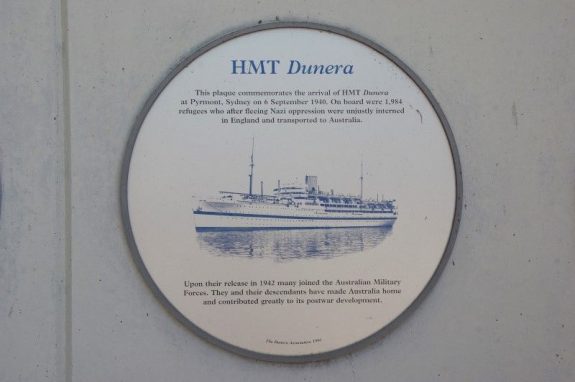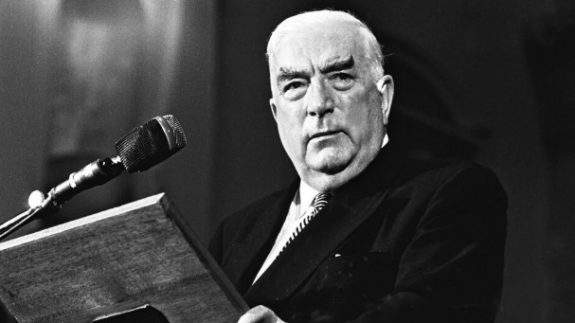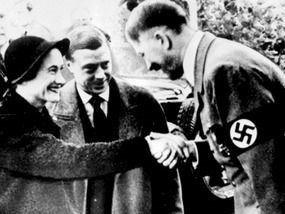The HMT Dunera scandal

By Dr George Venturini
The HMT Dunera scandal
In the spring of 1940 England was in the grip of a great panic over the possibility of an invasion by Nazi Germany. Enemy troops were just across the English Channel – less than fifty kilometres away.
In England, German, Italian and most European foreigners were feared as potential spies and agents provocateurs, who would join with the enemy if and when the Nazis invaded.
Consequently, the British government ordered all such adult subjects to be rounded up and interned. And that included even German Jewish refugees who had recently escaped from Nazi Germany and who were implacable enemies of the Nazis.
The majority were sent to the Isle of Man, a self-governing British Crown dependency in the Irish Sea between Great Britain and Ireland, where they could do little harm, but heavy suspicion fell on those men of military age, from 18 to 65, who were regarded as highly dangerous.
Those were to be sent all the way to Australia.
Those deported to Australia had to be kept under surveillance for the journey, and the British navy was able to supply a suitable troopship, the HMT (Hired Military Transport) Dunera. It was a secure military vessel and had originally been designed and equipped for 1,600 troops, but now was to be filled with 2,542 refugees aged between 16 and 60, besides the crew and the army warders. As a result, everyone was cramped and hugely uncomfortable.
Seventy per cent of the internees were Jewish refugees who had managed to escape from the Nazis and had arrived in England long before the outbreak of the war. The Dunera began loading on 10 July 1940. With 7 officers and over 300 others, a total of 2800 men were to be crammed on to a vessel built to hold 1600. The ship’s crew – 309 poorly trained soldiers – brutally searched and looted the internees’ luggage, some of which quite large, while the ship’s commanders, Lieutenant-Colonel William Scott and First Lieutenant John O’Neill, either stood by indifferently or actively participated. (C. Pearl, The Dunera scandal, Angus & Robertson, Sydney 1983)
The ship left Liverpool at midnight. Callously indifferent to the fate of the men, the British government allowed the Dunera only one destroyer escort. Less than 24 hours out of Liverpool, German submarine U-56 attacked; a but because the waves were heavy, the ship went up just as the torpedo passed underneath.
The 57 days of the voyage were a nightmare of inhuman conditions and brutal mistreatment. The lower decks of the ship were jammed, and men had to sleep on mess tables or on the floor. For weeks hatches were kept down. Neither daylight nor natural air ever reached the decks; the upper parts of the ship, where one would have been in the fresh air, were absolutely out of bounds, being barred by barbed wire and sentries with bayonets. Only ten toilets were available which meant long queues and ‘toilet police’ who would call up people as vacancies arose. Men slept on floors and benches, and if one wanted to go to the toilet at night he had to walk on bodies. Robbed of their luggage, the refugees had but the clothes on their backs; most of them had lost the basics: toothbrush, toothpaste, comb or soap. Later, the guards gave one piece of soap to every 20 men to share for 2 weeks but this was hardly enough to keep clean. If an internee became ill there was a half-hour waiting to see the doctor. Inoculations were non-existent. Food consisted of smoked fish, sausages, potatoes and a spoonful of melon and lemon jam a day; the bread was usually maggoty and the butter rancid.
The crew treated the refugees with extreme cruelty. The internees remained uninformed of their true destination until their own knowledge of geography and navigation by the stars – and arrival in a western coastal port of Africa – made further secrecy impossible. The crew searched the men daily, threatening them with loaded rifles fixed with bayonets. If guards found any vital medications, such as insulin, they threw them overboard. They also threw false teeth away, confiscated razors and shaving utensils and threatened men who hid their razors or were clean-shaven with detention in the bunker. Any valuables, hidden food, or Jewish religious vestments, phylacteries and prayer books were confiscated and either kept or thrown overboard. Beatings were daily.
Two internees died during the two-month voyage: Hans Pfeffen was sick when he boarded the Dunera at Liverpool and died in the ship’s hospital; Jacob Weiss suicided. Weiss had hoped to save his family from the Nazis in Europe and after 12 months of work and ultimately attaining immigration documents for himself and his family, he was arrested, interned and forced aboard the Dunera. When the guards on the ship found his immigration papers, they tore them up in front of him. Distraught, Weiss jumped overboard and drowned.
Prior to arrival in Australia, the crew ordered the internees to shave off their beards, providing the 2,542 men with 8 razors to do the task. The ship reached the Port of Fremantle in Western Australia on 27 August and Port Melbourne on 3 September. At Melbourne, two groups disembarked: the 251 German and Austrian ‘A’ Category internees whom the British government regarded as dangerous or potentially dangerous due to their political affiliations, along with 94 Germans and 200 Italians whose political affiliations were seen as “doubtful” since they were members of the Fascist Party in England. These men were interned at a camp at Tatura, Victoria.
Around 10 o’clock on the morning of 6 September 1940, fifty-seven days out of Liverpool, the Dunera entered Sydney Harbour. The remainder of the internees were sent to camps, at Hay and, later, at Orange in New South Wales.
The atmosphere was tense: on one hand, the press sniffed a sensational story – in its coverage, the Daily Telegraph reported that “among the internees were parachutists, other prisoners of war, and hundreds who had been carrying out subversive work in England.” On the other hand, the first Australian to board the ship, medical army officer Alan Frost, was appalled by the conditions that greeted him. His report led to the court martial of the officer-in-charge, Lt. Colonel William Scott. For the weary internees, “some in heavy overcoats, hats, others with summer wear having lost everything else, some orthodox Jews in their traditional black garb and hats.” they did not much look like spies as they left the ship. (S. G. Rosenberg, ‘HMT Dunera, the scandal and the salvation’, The Jerusalem Post, 12 December 2015).
The scandal was compounded by an initial tragedy: many of the internees had been living freely in Britain prior to September 1939, some having arrived there as children thanks to the Kindertransport organised by the Movement for the Care of Children from Germany after the Kristallnacht in November 1938. With the outbreak of war, they were under suspicion as potential fifth columnists who might secretly assist a German invasion. Prime Minister Winston Churchill declared had them declared as enemy aliens and swiftly had them shipped off to Canada and Australia.
Between the youngest aged sixteen and the oldest aged sixty-six, were future students or workers at Australian universities after their release from detention, and many became significant academic figures, including physicist Hans Buchdahl, economist Fred Gruen, philosopher Peter Herbst, political scientist Henry Mayer, fine arts scholar Franz Philipp, and mathematician turned oceanographer Rainer Radok – to mention just a few. Treated like dirt by their imprisoners, most of them went on to stellar careers as scientists, lawyers, entrepreneurs, industrialists, public servants and artists.
So it is not entirely surprising to find that Tatura had its own university – Collegium Taturense – which delivered an average of 113 lectures a week attended by nearly 700 students. Concerts, theatre performances and sports matches were another feature of life in the camps, as the internees did their best not only to fill time and combat boredom, but also to retain a sense of dignity and purpose in the face of an indefinite wait for freedom. As the editors of the first edition of the Hay camp newsletter, the Boomerang, put it in February 1941: “Please remember that your mind is not interned, nor is it confined to this camp.”
The injustice of the Dunera internees’ treatment was recognised by Churchill, who came to regret the decision to order the indiscriminate detention of those who had sought Britain’s protection. He apologised and instigated a court martial which documented the abuses the boys endured at sea. The Dunera’s senior officer was severely reprimanded and a regimental sergeant-major was discharged and goaled for theft. A fund of £35,000 was used to compensate the Dunera internees for their lost and stolen property.
Their treatment in Australia began to change too. By mid 1942 at least 1,300 had been set free, hundreds of them returning to England as soon as they could. Fewer than half of the internees remained in Australia; the rest returned to Britain, emigrated to the United States, helped found the state of Israel or ended up in a variety of other counties. A few dozen returned to divided Germany. (P. Mares, ‘Remembering the Dunera’, insidestory.org.au, 13 July 2018, being a review of K. Inglis, S. Spark and J. Winter with C. Bunyan, Dunera Lives: A Visual History, publishing.monash.edu/books, July 2018).
Continued Wednesday – Beyond the ‘Palace Letters’ (part 1)
Previous instalment – The Kimberley Plan
 Dr. Venturino Giorgio Venturini devoted some seventy years to study, practice, teach, write and administer law at different places in four continents. He may be reached at George.venturini@bigpond.com.au.
Dr. Venturino Giorgio Venturini devoted some seventy years to study, practice, teach, write and administer law at different places in four continents. He may be reached at George.venturini@bigpond.com.au.
Like what we do at The AIMN?
You’ll like it even more knowing that your donation will help us to keep up the good fight.
Chuck in a few bucks and see just how far it goes!












